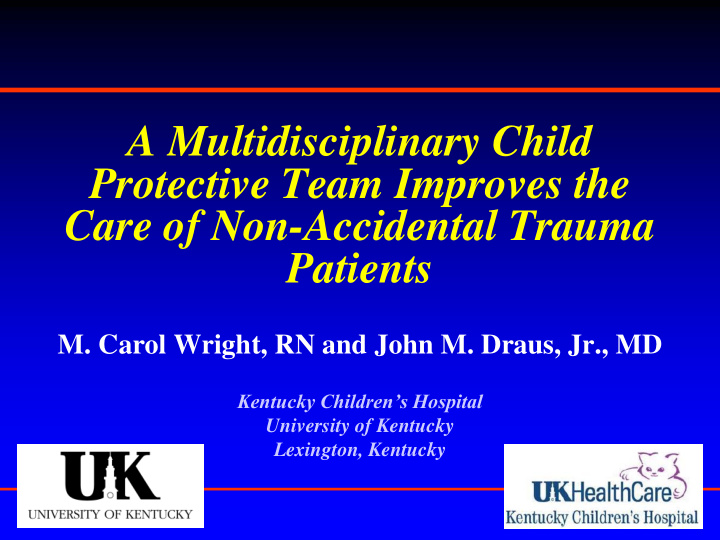



A Multidisciplinary Child Protective Team Improves the Care of Non-Accidental Trauma Patients M. Carol Wright, RN and John M. Draus, Jr., MD Kentucky Children’s Hospital University of Kentucky Lexington, Kentucky
Child Abuse in the U.S. In 2013, there were an estimated 679,000 victims of child abuse and neglect (9.1 victims per 1,000 children). 1,520 children died from abuse and neglect (2.04 deaths per 100,000 children). The incidence of physical abuse was highest in children less than one-year-old (51.1 per 1,000 children). 80% of deaths occurred in children younger than 4 years-old. www.acf.hhs.gov
Child Abuse in Kentucky Kentucky consistently ranks among the nation’s highest in terms of rates of victimization and mortality. In 2007, we had the highest rate of deaths from abuse and neglect. In 2013, we had an overall incidence of 19.7 victims per 100,000 children. In 2013, the child fatality rate was 2.27 deaths per 100,000 children. www.everychildmatters.org
BACKGROUND In February 2014, we formalized a multidisciplinary Child Protection Team (CPT). Designated as a subgroup of our pediatric multidisciplinary trauma peer review committee. NAT patient data are entered into our hospital’s trauma registry. CPT meetings are held monthly. Non-accidental trauma (NAT) patients from the preceding month are reviewed. Attendance is recorded, and minutes are kept.
CPT Meetings The meeting has two parts: • The open portion focuses on discussion of specific cases. Child Protective Services (CPS) workers and criminal investigators are invited to participate. • The closed portion focuses on performance improvement and patient safety (PIPS), education, and outreach.
Child Protection Team
METHODS Purpose of Study: • We sought to review the effectiveness and accomplishments of our Child Protection Team. Study Design: • We retrospectively reviewed the minutes from our CPT meetings. • Study Period – February 2014 through April 2015 • Trauma registry queried • We tracked attendance, cases reviewed, PIPS, and education and outreach programs.
RESULTS Attendance Meeting attendance was very good – 78%
RESULTS NAT patient volumes 141 suspected NAT cases 96 cases reviewed for CPT meeting 13 cases discussed with CPS or law enforcement
RESULTS NAT patient characteristics 87 patients in trauma registry Median age 6 months, range newborn to 10 years 55% male 87.4% Caucasian, 6.9% African-American, and 5.7% Hispanic Median ISS 4, range 1 to 35 7 operations 15 PICU admissions, median LOS 3 days, range 1 to 11 days Median hospital LOS 2 days, range 0 to 22 days 3 deaths
RESULTS PIPS – Clinical Practice Guideline
RESULTS PIPS – FUSS Completion Following NAT patients in our pediatric surgical clinic successfully increased our rates of FUSS completion (40% vs. 92%, p<0.001).
RESULTS PIPS – Corrective Action Standardized letters • 6 letters notifying individuals of care concerns and opportunities for improvement. Continual follow-up with our Neurosurgery and Orthopedic Surgery teams has increased awareness.
RESULTS PIPS Equipment needs • Digital camera • Speaker phone Increased focus of hospital social workers. Recent hiring of 2 child abuse specialists.
RESULTS Education and Outreach 2014 Kentucky Statewide Trauma and Emergency Medicine Symposium Quarterly Prehospital Quality Meeting Through the Looking Glass: A Review of Child Abuse Evaluation and Resuscitation • Ephriam McDowell Hospital • April 28, 2015
CONCLUSIONS Our CPT meeting has improved the care of our NAT patients. We have successful raised the awareness of NAT at our institution. It has provided better communication between our hospital and CPS workers. We have improved in-hospital processes for our NAT patients. We have provided educational opportunities to outside care providers.
QUESTIONS?
Recommend
More recommend